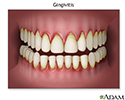Gingivostomatitis
Gingivostomatitis is an infection of the mouth and gums that leads to swelling and sores. It may be due to a virus or bacteria.
Causes
Gingivostomatitis is common among children. It may occur after infection with the herpes simplex virus type 1 (HSV-1), which also causes cold sores.
Cold sores.
Herpetic stomatitis is a viral infection of the mouth that causes sores and ulcers. These mouth ulcers are not the same as canker sores, which are n...

The condition may also occur after infection with a coxsackie virus .
Coxsackie virus
Herpangina is a viral illness that involves ulcers and sores (lesions) inside the mouth, a sore throat, and fever. Hand, foot, and mouth disease is a...

It may occur in people with poor oral hygiene.
Symptoms
The symptoms can be mild or severe and may include:
-
Bad breath
Bad breath
Breath odor is the scent of the air you breathe out of your mouth. Unpleasant breath odor is commonly called bad breath.
Read Article Now Book Mark Article - Fever
- General discomfort, uneasiness, or ill feeling (malaise)
- Sores on the inside of the cheeks or gums
- Very sore mouth with no desire to eat
Exams and Tests
Your health care provider will check your mouth for small ulcers. These sores are similar to mouth ulcers caused by other conditions. Cough, fever, or muscle aches may indicate other conditions.
Most of the time, no special tests are needed to diagnose gingivostomatitis. However, the doctor may take a small piece of tissue from the sore to check for a viral or bacterial infection. This is called a culture. A biopsy may be done to rule out other types of mouth ulcers.
Biopsy
A biopsy is the removal of a small piece of tissue for laboratory examination.
Treatment
The goal of treatment is to reduce symptoms.
Things you can do at home include:
-
Practice good
oral hygiene
. Brush your gums well to reduce the risk of getting another infection.
Oral hygiene
Tooth decay and gum disease are caused by plaque, a sticky combination of bacteria and food. Plaque begins to build up on teeth within 20 minutes af...
Read Article Now Book Mark Article - Use mouth rinses that reduce pain if your doctor recommends them.
- Rinse your mouth with salt water (one-half teaspoon or 3 grams of salt in 1 cup or 240 milliliters of water) or mouthwashes with hydrogen peroxide or Xylocaine to ease discomfort.
- Eat a healthy diet. Soft, bland (non-spicy) foods may reduce discomfort during eating.
You may need to take antibiotics.
You may need to have the infected tissue removed by the dentist (called debridement).
Outlook (Prognosis)
Gingivostomatitis infections range from mild to severe and painful. The sores often get better in 2 or 3 weeks with or without treatment. Treatment may reduce discomfort and speed healing.
Possible Complications
Gingivostomatitis may disguise other, more serious mouth ulcers.
When to Contact a Medical Professional
Call your health care provider if:
- You have mouth sores and fever or other signs of illness
- Mouth sores get worse or do not respond to treatment within 3 weeks
References
Christian JM, Goddard AC, Gillespie MB. Deep neck and odontotogenic infections. In: Flint PW, Haughey BH, Lund LJ, et al, eds. Cummings Otolaryngology: Head & Neck Surgery . 6th ed. Philadelphia, PA: Elsevier Mosby; 2015:chap 10.
Romero JR, Modlin. Coxsackieviruses, echovirsuses, and numbered enteroviruses. JF In: Bennett JE, ed. Mandell, Douglas, and Bennett's Principles and Practice of Infectious Diseases . 8th ed. Philadelphia, PA: Elsevier Churchill Livingstone; 2015:chap 174.
Schiffer JT, Corey L. Herpes simplex virus. In: Bennett JE, ed. Mandell, Douglas, and Bennett's Principles and Practice of Infectious Diseases . 8th ed. Philadelphia, PA: Elsevier Churchill Livingstone; 2015:chap 138.
-
Gingivitis - illustration
Inflammation of the gums is called gingivitis. Bacteria in plaque around the teeth release enzymes (collagenases) that can damage and erode the gum tissues. The infected gums swell, bleed easily, recede, and loosen from the teeth. Tooth loss is caused more frequently by gum disease than tooth decay.
Gingivitis
illustration
-
Gingivitis - illustration
Gingivitis is an inflammation of the gums caused by plaque and bacteria accumulation.
Gingivitis
illustration
-
Gingivitis - illustration
Inflammation of the gums is called gingivitis. Bacteria in plaque around the teeth release enzymes (collagenases) that can damage and erode the gum tissues. The infected gums swell, bleed easily, recede, and loosen from the teeth. Tooth loss is caused more frequently by gum disease than tooth decay.
Gingivitis
illustration
-
Gingivitis - illustration
Gingivitis is an inflammation of the gums caused by plaque and bacteria accumulation.
Gingivitis
illustration
Review Date: 2/13/2015
Reviewed By: Sumana Jothi MD, otolaryngology-head and neck surgery, airway, voice, and swallowing disorders, clinical instructor UCSF Otolaryngology, NCHCS VA, SFVA, San Francisco, CA. Review provided by VeriMed Healthcare Network. Also reviewed by David Zieve, MD, MHA, Isla Ogilvie, PhD, and the A.D.A.M. Editorial team.


